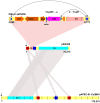The sudden dominance of blaCTX-M harbouring plasmids in Shigella spp. Circulating in Southern Vietnam
- PMID: 20544028
- PMCID: PMC2882334
- DOI: 10.1371/journal.pntd.0000702
The sudden dominance of blaCTX-M harbouring plasmids in Shigella spp. Circulating in Southern Vietnam
Abstract
Background: Plasmid mediated antimicrobial resistance in the Enterobacteriaceae is a global problem. The rise of CTX-M class extended spectrum beta lactamases (ESBLs) has been well documented in industrialized countries. Vietnam is representative of a typical transitional middle income country where the spectrum of infectious diseases combined with the spread of drug resistance is shifting and bringing new healthcare challenges.
Methodology: We collected hospital admission data from the pediatric population attending the hospital for tropical diseases in Ho Chi Minh City with Shigella infections. Organisms were cultured from all enrolled patients and subjected to antimicrobial susceptibility testing. Those that were ESBL positive were subjected to further investigation. These investigations included PCR amplification for common ESBL genes, plasmid investigation, conjugation, microarray hybridization and DNA sequencing of a bla(CTX-M) encoding plasmid.
Principal findings: We show that two different bla(CTX-M) genes are circulating in this bacterial population in this location. Sequence of one of the ESBL plasmids shows that rather than the gene being integrated into a preexisting MDR plasmid, the bla(CTX-M) gene is located on relatively simple conjugative plasmid. The sequenced plasmid (pEG356) carried the bla(CTX-M-24) gene on an ISEcp1 element and demonstrated considerable sequence homology with other IncFI plasmids.
Significance: The rapid dissemination, spread of antimicrobial resistance and changing population of Shigella spp. concurrent with economic growth are pertinent to many other countries undergoing similar development. Third generation cephalosporins are commonly used empiric antibiotics in Ho Chi Minh City. We recommend that these agents should not be considered for therapy of dysentery in this setting.
Conflict of interest statement
The authors have declared that no competing interests exist.
Figures




Similar articles
-
Molecular characterization of the extended-spectrum beta-lactamase (ESBL)-producing Shigella spp. in Shanghai.Eur J Clin Microbiol Infect Dis. 2015 Mar;34(3):447-51. doi: 10.1007/s10096-014-2244-2. Epub 2014 Sep 25. Eur J Clin Microbiol Infect Dis. 2015. PMID: 25252628
-
Molecular characterization of ESBL-producing Shigella sonnei isolates from patients with bacilliary dysentery in Lebanon.J Infect Dev Ctries. 2009 May 1;3(4):300-5. doi: 10.3855/jidc.128. J Infect Dev Ctries. 2009. PMID: 19759494
-
Antimicrobial resistance, virulence & plasmid profiles among clinical isolates of Shigella serogroups.Indian J Med Res. 2019 Feb;149(2):247-256. doi: 10.4103/ijmr.IJMR_2077_17. Indian J Med Res. 2019. PMID: 31219090 Free PMC article.
-
Complete nucleotide sequence of the IncI1 plasmid pSH4469 encoding CTX-M-15 extended-spectrum β-lactamase in a clinical isolate of Shigella sonnei from an outbreak in the Republic of Korea.Int J Antimicrob Agents. 2014 Dec;44(6):533-7. doi: 10.1016/j.ijantimicag.2014.08.007. Epub 2014 Sep 28. Int J Antimicrob Agents. 2014. PMID: 25446906
-
Evaluation of antimicrobial resistance among Salmonella and Shigella isolates in the University Hospital "St. George," Plovdiv, Bulgaria.Folia Microbiol (Praha). 2017 Mar;62(2):117-125. doi: 10.1007/s12223-016-0478-3. Epub 2016 Oct 19. Folia Microbiol (Praha). 2017. PMID: 27761725
Cited by
-
In vitro selection of variants resistant to beta-lactams plus beta-lactamase inhibitors in CTX-M beta-lactamases: predicting the in vivo scenario?Antimicrob Agents Chemother. 2011 Oct;55(10):4530-6. doi: 10.1128/AAC.00178-11. Epub 2011 Jul 25. Antimicrob Agents Chemother. 2011. PMID: 21788458 Free PMC article.
-
F33:A-:B- and F2:A-:B- plasmids mediate dissemination of rmtB-blaCTX-M-9 group genes and rmtB-qepA in Enterobacteriaceae isolates from pets in China.Antimicrob Agents Chemother. 2011 Oct;55(10):4926-9. doi: 10.1128/AAC.00133-11. Epub 2011 Jul 25. Antimicrob Agents Chemother. 2011. PMID: 21788459 Free PMC article.
-
The genomic signatures of Shigella evolution, adaptation and geographical spread.Nat Rev Microbiol. 2016 Apr;14(4):235-50. doi: 10.1038/nrmicro.2016.10. Epub 2016 Feb 29. Nat Rev Microbiol. 2016. PMID: 26923111 Review.
-
Clinical and microbiological profiles of shigellosis in children.J Health Popul Nutr. 2014 Dec;32(4):580-6. J Health Popul Nutr. 2014. PMID: 25895190 Free PMC article.
-
Differential phenotypic and genotypic characteristics of qnrS1-harboring plasmids carried by hospital and community commensal enterobacteria.Antimicrob Agents Chemother. 2011 Apr;55(4):1798-802. doi: 10.1128/AAC.01200-10. Epub 2011 Jan 31. Antimicrob Agents Chemother. 2011. PMID: 21282449 Free PMC article.
References
-
- Livermore DM, Canton R, Gniadkowski M, Nordmann P, Rossolini GM, et al. CTX-M: changing the face of ESBLs in Europe. J Antimicrob Chemother. 2007;59:165–174. - PubMed
-
- Rossolini GM, D'Andrea MM, Mugnaioli C. The spread of CTX-M-type extended-spectrum beta-lactamases. Clin Microbiol Infect. 2008;14(Suppl 1):33–41. - PubMed
-
- Heffernan HM, Woodhouse RE, Pope CE, Blackmore TK. Prevalence and types of extended-spectrum beta-lactamases among urinary Escherichia coli and Klebsiella spp. in New Zealand. Int J Antimicrob Agents 2009 - PubMed
-
- Pitout JD, Laupland KB. Extended-spectrum beta-lactamase-producing Enterobacteriaceae: an emerging public-health concern. Lancet Infect Dis. 2008;8:159–166. - PubMed
-
- Valverde A, Coque TM, Garcia-San Miguel L, Baquero F, Canton R. Complex molecular epidemiology of extended-spectrum beta-lactamases in Klebsiella pneumoniae: a long-term perspective from a single institution in Madrid. J Antimicrob Chemother. 2008;61:64–72. - PubMed
Publication types
MeSH terms
Substances
Grants and funding
LinkOut - more resources
Full Text Sources
Other Literature Sources
Medical
Miscellaneous

